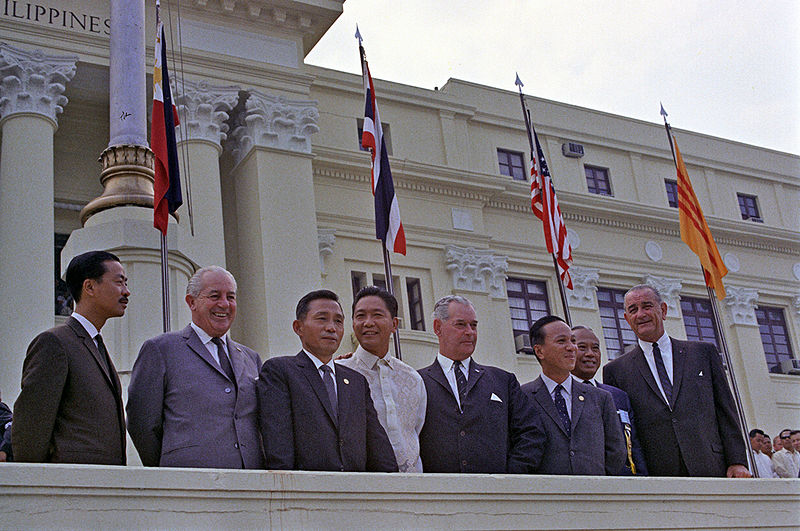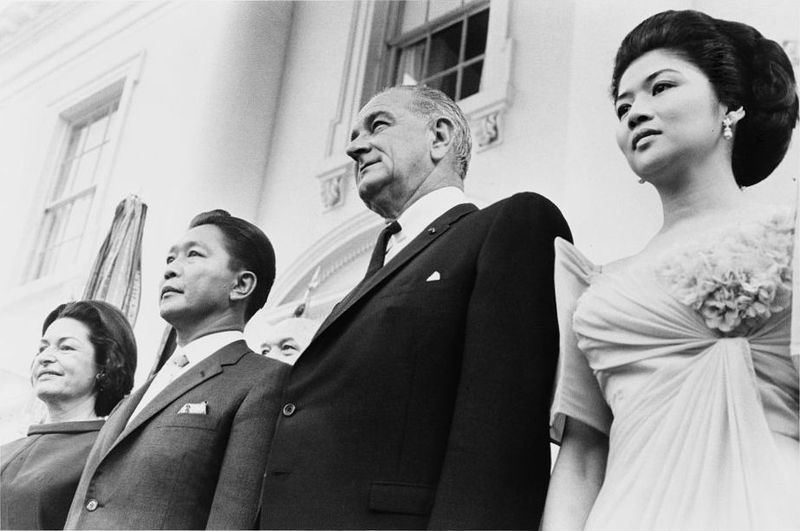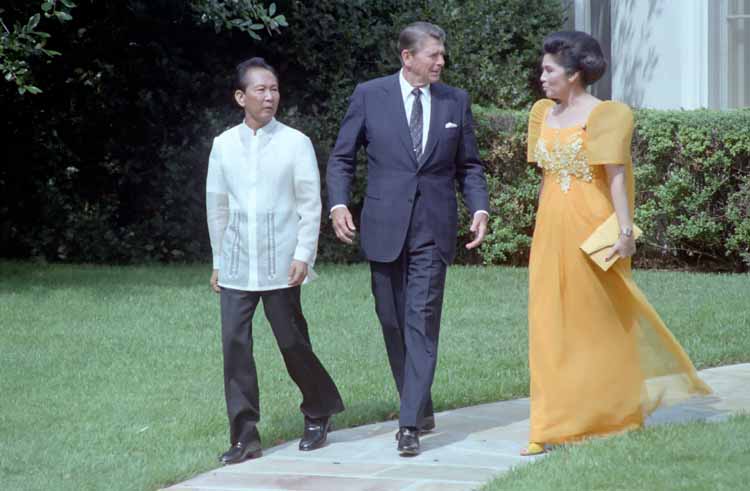<Back to Index>
- Naturalist Ulisse Aldrovandi, 1522
- Novelist David Herbert Richards Lawrence, 1885
- President of the Philippines Ferdinand Emmanuel Edralin Marcos, 1917
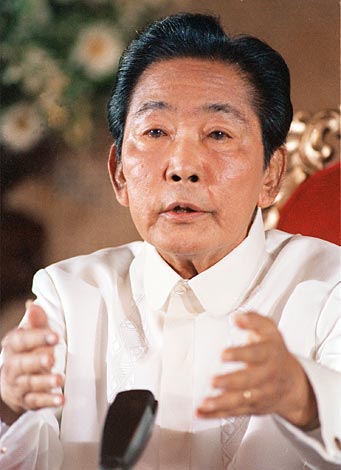
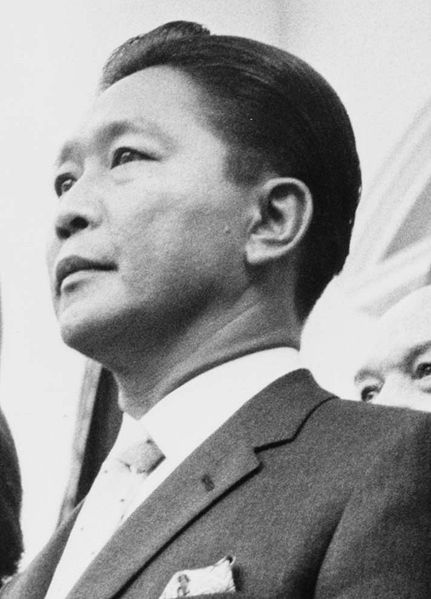
Ferdinand Emmanuel Edralin Marcos (September 11, 1917 – September 28, 1989) was President of the Philippines from 1965 to 1986. He was a lawyer, member of the Philippine House of Representatives (1949–1959) and a member of the Philippine Senate (1959–1965). He was Senate President in 1963. He claimed that during World War II he had been the leader of Ang Maharlika, a guerrilla force in northern Luzon. As Philippine president and strongman, his greatest achievement was in the fields of infrastructure development and international diplomacy. However, his administration was marred by massive authoritarian corruption, despotism, nepotism, political repression, and human rights violations. He benefited from a large personality cult in the Philippines during his regime. In 1983, his government was implicated in the assassination of his primary political opponent, Benigno Aquino, Jr.. The implication caused a chain of events, including a tainted presidential election that served as the catalyst for the People Power Revolution in February 1986 that led to his removal from power and eventual exile in Hawaii. It was later alleged that he and his wife Imelda Marcos had moved billions of dollars of embezzled public funds to the United States, Switzerland, and other countries, as well as into fictitious corporations during his 20 years in power.
Ferdinand Emmanuel Edralin Marcos was born September 11, 1917, in Sarrat, Ilocos Norte outside Laoag City to parents Mariano Marcos and Josefa Edralin. He was named after Ferdinand VII of Spain and baptized into the Philippine Independent Church. According to the Marcos family's oral history, the family name was originally Taguktok, and their Ilokano roots have some Japanese and Chinese ancestry. Ferdinand was a champion debater at the University of the Philippines, where he also participated in boxing, swimming and wrestling.
In December 1938, Mariano Marcos, his brother Pio, his son Ferdinand, and his brother-in-law Quirino Lizardo were prosecuted for the murder of Julio Nalundasan. On September 20, 1935, the day after Nalundasan for the second time defeated Mariano Marcos for the National Assembly seat for Ilocos Norte, Nalundasan had been shot and killed in his house in Batac. According to two witnesses, the four had conspired to assassinate Nalundasan, with Ferdinand Marcos eventually doing the killing. Late January 1939 they were denied bail, and in the fall of 1939 they were convicted, Ferdinand and Lizardo receiving the death penalty for premeditated murder, while Mariano and Pio were found guilty only of contempt of court. The Marcos family took their appeal to the Supreme Court of the Philippines, which on October 22, 1940, overturned the lower court's decision and acquitted them of all charges but contempt.
In 1939, while incarcerated, Ferdinand Marcos graduated cum laude with a law degree from the U.P. College of Law and was elected to the Pi Gamma Mu international honor society. While in detention Governor Roque B. Ablan Sr. of Ilocos Norte helped Marcos study for the bar exams by providing a desk lamp in his cell, law books and reviewers. Marcos passed the bar examination with an almost perfect score of 98.01%, while also writing an 830-page defense. Several people contested his score and a retake was taken albeit an oral bar examination witnessed by several people. His second bar examination resulted in a 92.35% score (21st in an all-time list of highest grades obtained in the Philippine Bar).
Marcos became senator after serving as member of the House of Representatives for three terms. In the Senate he served as minority floor leader before gaining the Senate presidency. He established a record for having introduced a number of significant bills, many of which found their way into the republic's statute books.
He was married to Imelda Romualdez-Marcos, with four children: Maria Imelda "Imee" Marcos, Ferdinand "Bongbong" Marcos, Jr., Irene Marcos, and Aimee Marcos, who was adopted.
The
cabinet appointments of President Marcos can be divided into three
periods: his first two constitutional terms (1965–1973), the New
Society appointments from 1973–1978, and the change from departments to
ministries from 1978 to the end of his government. To rally the people, he vowed to fulfill the nation’s “mandate for greatness:” This
nation can be great again. This I have said over and over. It is my
articles of faith, and Divine Providence has willed that you and I can
now translate this faith into deeds. In
his first State of the Nation Address (SONA), President Marcos revealed
his plans for economic development and good government. President
Marcos wanted the immediate construction of roads, bridges and public
works, which included 16,000 kilometers of feeder roads, some 30,000
lineal meters of permanent bridges, a generator with an electric power
capacity of one million kilowatts and water
services to eight regions and 38 localities. He
also urged the revitalization of the judiciary, the national defense
posture and the fight against smuggling, criminality, and graft and
corruption in the government.
To
accomplish his goals “President Marcos mobilized the manpower and
resources of the Armed Forces of the Philippines (AFP) for action to
complement civilian agencies in such activities as infrastructure
construction; economic planning and program execution; regional and
industrial site planning and development; community development and
others.” The President, likewise, hired technocrats and highly educated persons to form part of the cabinet and staff. The
employment of technocrats in key positions and the mobilization of the
AFP for civic actions resulted in the increasing functional integration
of civilian and military elites. It was during his first term that the North Diversion Road (now, North Luzon Expressway) was constructed with the help of the AFP engineering construction battalion.
From October 1965, when the administration of president Marcos was founded (during the Vietnam War), over 10,450 Filipino soldiers were sent to South Vietnam under the designation of PHLCAAG or Philippines Civil Affairs Assistance Group.
In 1969 incumbent Marcos won an unprecedented second full term as President of the Philippines. Marcos was the last president in the entire electoral history who ran and won for a second term. His running mate, incumbent Vice President Fernando Lopez was also elected to a third full term as Vice President of the Philippines. An unprecedented twelve candidates ran for president, however ten of those were nuisance candidates. It is generally known that Marcos had the most infrastructure and
constitutional accomplishments, which were equivalent to those of all
former presidents of the Philippines. During his second term he developed a personality cult in
the Philippines surrounding him, requiring businesses and schools all
across the Philippines to have his official presidential picture or
their facilities shut down. In addition, Marcos's propaganda messages
were placed all across the Philippines, many of them taking the place
of billboard advertisements. The personality cult lasted until his deposition in 1986. The
second term proved to be a daunting challenge to the president: an
economic crisis brought by external and internal forces, a restive and
radicalized studentry demanding reforms in the educational system, a
rising tide of criminality, subversion by the re-organized Communist
movement, and secession in the south.
Critics
claimed that overspending in the 1969 elections led to higher inflation
and the devaluation of the Philippine peso but the assertion was never
verified. Media also discounted the fact that Marcos had already
accumulated a lot of wealth prior to his entering politics and had
invested in precious metals prior to running for office. In addition,
the Philippine economy suffered from the effects of the Cold War, as
there was an increased uprising of the "leftist" movement that created
widespread chaos throughout the provinces. Further, the decision of the
oil-producing Arab countries to cut back oil production, in response to
Western military aid to Israel in the Arab-Israeli conflict, resulted
in higher fuel prices worldwide. Also, natural calamities brought havoc
to infrastructures and agricultural crops and livestock. The combined
external and internal economic forces led to uncontrolled increase in
the prices of prime commodities. The
last years of the 1960s and the first two years of the 1970s witnessed
the radicalization of the country's student population. Students in
various colleges and universities held massive rallies and
demonstrations to express their frustrations and resentments. On
January 30, 1970, demonstrators numbering about 50,000 students and
laborers stormed the Malacañang Palace, burning part of the
medical building and crashing through Gate 4 with a fire truck that had
been forcibly commandeered by laborers and students. The Metropolitan
Command (Metrocom) of the Philippine Constabulary (PC) repulsed them,
pushing them toward Mendiola Bridge, where, hours later, after an
exchange of gunfire, four persons were killed and scores from both
sides injured. Tear gas grenades finally dispersed the crowd. The event is known today as the First Quarter Storm. Violent
students protests did not end. In October 1970, a series of violent
events occurred on numerous campuses in the Greater Manila Area, cited
as “an explosion of pillboxes in at least two schools.” The University
of the Philippines was not spared when 18,000 students boycotted their
classes to demand academic and non-academic reforms in the State
University, ending in the ‘occupation’ of the office of the president
of the university by student leaders. Other schools in which scenes of
violent student demonstrations occurred were San Sebastian College, the
University of the East, Letran College, Mapua Institute of Technology,
the University of Santo Tomas, Feati University and the Philippine
College of Commerce (now Polytechnic University of the Philippines).
Student demonstrators even succeeded in “occupying the office of the
Secretary of Justice Vicente Abad Santos for at least seven hours.” The
president described the brief “communization” of the University of the
Philippines and the violent demonstrations of the left-leaning students
as an “act of insurrection." Amidst the rising wave of lawlessness and the threat of a Communist insurgency, Marcos declared martial law on September 21, 1972, by virtue of Proclamation No. 1081.
Marcos, ruling by decree, curtailed press freedom and other civil
liberties, closed down Congress and media establishments, and ordered
the arrest of opposition leaders and militant activists, including his
staunchest critics, senators Benigno Aquino, Jr., Jovito Salonga and Jose Diokno. The declaration of martial law was initially well received, given the social turmoil the Philippines was experiencing. Crime rates plunged dramatically after a curfew was implemented. Many political opponents were forced to go into exile. A constitutional convention, which had been called for in 1970 to replace the colonial 1935 Constitution, continued the work of framing a new constitution after the declaration
of martial law. The new constitution went into effect in early 1973,
changing the form of government from presidential to parliamentary and allowing Marcos to stay in power beyond 1973. Marcos claimed that martial law was the prelude to creating his Bagong Lipunan, a "New Society" based on new social and political values. The economy during the 1970s was robust, with budgetary and trade surpluses. The Gross National Product rose
from P55 billion in 1972 to P193 billion in 1980. Tourism rose,
contributing to the economy's growth. However, Marcos, his cronies and
his wife, Imelda Romualdez-Marcos, wilfully engaged in rampant corruption. After
putting in force amendments to the constitution, legislative action,
and securing his sweeping powers and with the Batasan under his
control, President Marcos lifted martial law on January 17, 1981.
However, the suspension of the privilege of the writ of habeas corpus continued in the autonomous regions of Western Mindanao and Central Mindanao. The opposition dubbed the lifting of martial law as a mere "face lifting" as a precondition to the visit of Pope John Paul II. Marcos had a vision of a Bagong Lipunan (New Society) similar to Indonesian president Suharto's "New Order administration". He used the years of martial law to implement this vision. According
to Marcos's book, "Notes on the New Society," it was a movement urging
the poor and the privileged to work as one for the common goals of
society and to achieve the liberation of the Filipino people through
self-realization. Marcos confiscated businesses owned by the oligarchy.
More often than not, they were taken over by Marcos's family members
and close personal friends, who used them as fronts to launder proceeds
from institutionalized graft and corruption in the different national
governmental agencies as "crony capitalism," Marcos' friends using them
for personal benefit. With genuinely nationalistic motives, crony
capitalism was intended to redistribute monopolies traditionally owned
by Chinese and Mestizo oligarchs to Filipino businessmen though in
practice, it led to graft and corruption via bribery, racketeering, and embezzlement.
Marcos also silenced the free press, making the state press the only
legal one. He also seized privately owned lands and distributed them to
farmers. By waging an ideological war against the oligarchy, Marcos
gained the support of the masses though he was to create a new one in
its place. Marcos, now free from day-to-day governance which was left
mostly to Enrile using
his power to settle scores against old rivals, such as the Lopezes, who
were always opposed to the Marcos administration. Leading opponents
such as Senators Benigno Aquino, Jr., Jose Diokno, Jovito Salonga and
many others were imprisoned for months or years. This practice
considerably alienated the support of the old social and economic elite
and the media, who criticized the Marcos administration endlessly. The
declaration of martial law was initially very well received, given the
social turmoil the Philippines was experiencing though the rest of the
world was surprised at how the Filipinos accepted Marcos's self-imposed
dictatorship. Soon after Marcos declared martial law, one American
official described the Philippines as a country composed "of 40 million cowards and one son of a bitch"; otherwise, he reasoned, they should have risen against the destroyer of their freedom. Crime
rates plunged dramatically after dusk curfews were implemented and the
country would enjoy economic prosperity throughout the 1970s in the
midst of growing dissent to his strong-willed rule toward the end of
martial law. Political opponents were given the opportunity of
compliance or forced to go into exile. As a result, thousands migrated
to other countries, like the U.S. and Canada. Public dissent on the
streets was not tolerated and leaders of such protests were promptly
arrested, detained, tortured, or never heard from again. Communist
leaders, as well as sympathizers, were forced to flee from the cities
to the countryside, where they multiplied. Lim Seng,
a feared drug lord, was arrested and executed in Luneta in 1972. As
martial law dragged on for the next nine years, human rights violations
went unchecked, and graft and corruption by the military and the
administration became widespread, as made manifest by the Rolex 12. Over
the years, Marcos's hand was strengthened by the support of the armed
forces, whose size he tripled to 230,000 troops, after declaring
martial law in 1972. The forces included some first-rate units as well
as thousands of unruly and ill equipped personnel of the civilian home
defense forces and other paramilitary organizations. Defense Minister Juan Ponce Enrile, Chief of Staff of the Philippine Constabulary Fidel Ramos, and Chief of Staff of the Armed Forces of the Philippines Fabian Ver were
the chief administrators of martial law from 1972 to 1981, and the
three remained President Marcos's closest advisers until he was ousted
in 1986. Enrile and Ramos would later abandon Marcos's 'sinking ship' and seek protection behind the 1986 People Power Revolution. The Catholic hierarchy and Manila's middle class were crucial to the success of the massive crusade. In 1978, the position returned when Ferdinand Marcos became Prime Minister. Based on Article 9 of the 1973 constitution,
it had broad executive powers, that would be typical of modern prime
ministers in other countries. The position was the official head of
government, and the commander-in-chief of the armed forces. All of the
powers of the President based on the previous 1935 constitution were
transferred to the Prime Minister. The Prime Minister also acts as head
of the National Economic Development Authority. Marcos was replaced by Cesar Virata in 1981. On June 16, 1981, six months after the lifting of martial law, the first presidential election in twelve years was
held. As to be expected, President Marcos ran and won a massive victory
over the other candidates. The major opposition parties, the United Nationalists Democratic Organizations (UNIDO), a coalition of opposition parties and LABAN, boycotted the elections. In 1983, opposition leader Benigno Aquino, Jr. was assassinated at the Manila International Airport upon
his return to the Philippines after a long period of exile. This
coalesced popular dissatisfaction with Marcos and began a succession of
events, including pressure from the United States. Ronald
Reagan and Ferdinand Marcos have always shared a very friendly
relationship. There have been allegations that sizable illicit payments
were paid to Reagan. On
August 13, 1985, fifty-six Assemblymen signed a resolution calling for
the impeachment of President Marcos for graft and corruption, culpable
violation of the Constitution, gross violation of his oath of office
and other high crimes. They
cited the San Jose Mercury News exposé of the Marcoses’
multi-million dollar investment and property holdings in the United
States. The properties allegedly amassed by the First Family were the
Crown Building, Lindenmere Estate, and a number of residential
apartments (in New Jersey and New York), a shopping center in New York,
mansions (in London, Rome and Honolulu), the Helen Knudsen Estate in
Hawaii and three condominiums in San Francisco, California. The
Assemblymen also included in the complaint the misuse and
misapplication of funds “for the construction of the Film Center, where
X-rated and pornographic films are exhibited, contrary to public morals
and Filipino customs and traditions.” The
following day, the Committee on Justice, Human Rights and Good
Government dismissed the impeachment complain for being insufficient in
form and substance. During
these years, Marcos's regime was marred by rampant corruption and
political mismanagement by his relatives and cronies, which culminated to the assassination of Benigno Aquino, Jr. Critics considered Marcos the quintessential kleptocrat,
having looted billions of dollars from the Filipino treasury. The large
personality cult in the Philippines surrounding Marcos also led to
disdain. During his third term, Marcos's health deteriorated rapidly due to kidney ailments, often described as lupus erythematosus.
He was absent for weeks at a time for treatment, with no one to assume
command. Marcos's regime was sensitive to publicity of his condition; a
palace physician who alleged that during one of these periods Marcos
had undergone a kidney transplant was
shortly found murdered. Many people questioned whether he still had
capacity to govern, due to his grave illness and the ballooning
political unrest. With
Marcos ailing, his equally powerful wife, Imelda, emerged as the
government's main public figure. Marcos dismissed speculations of his
ailing health as he used to be an avid golfer and fitness buff who
liked showing off his physique. In light of these growing problems, the
assassination of Aquino in 1983 would later prove to be the catalyst
that led to his overthrow. Many Filipinos came to believe that Marcos,
a shrewd political tactician, had no hand in the murder of Aquino but
that he was involved in cover-up measures. However, the opposition
blamed Marcos directly for the assassination while others blamed the
military and his wife, Imelda. The 1985 acquittals of Ver as well as
other high-ranking military officers for the crime were widely seen as
a miscarriage of justice. By 1984, his close personal ally, U.S. President Ronald Reagan,
started distancing himself from the Marcos regime that he and previous
American presidents had strongly supported even after Marcos declared
martial law. The United States, which had provided hundreds of millions of dollars in aid, was crucial in buttressing Marcos's rule over the years. During the Carter administration the relation with the U.S. soured somewhat when President Jimmy Carter targeted the Philippines in his human rights campaign. In
the face of escalating public discontent and under pressure from
foreign allies, Marcos called a snap presidential election for 1986,
with more than a year left in his term. He selected Arturo Tolentino as his running mate. The opposition united behind Aquino's widow, Corazon, and her running mate, Salvador Laurel. The "People Power movement"
drove Marcos into exile and installed Corazon Aquino as the new
president. At the height of the revolution, Enrile revealed that his
ambush was faked in order for Marcos to have a pretext for imposing
martial law. However, Marcos maintained that he was the duly elected
and proclaimed president of the Philippines for a fourth term. The
Philippine government today is still paying interest in public debts
incurred during Marcos' administration. It was reported that, when
Marcos fled, U.S. Customs agents discovered 24 suitcases of gold bricks
and diamond jewelry hidden in diaper bags and in addition, certificates
for gold bullion valued in the billions of dollars were allegedly among
the personal properties he, his family, his cronies and business
partners surreptitiously took with them when the Reagan administration
provided them safe passage to Hawaii, Marcos' wife found to have over
2500 pairs of shoes in her closet. Economic
performance during the Marcos era was strong at times, but when looked
at over his whole regime it was not characterized by strong economic
growth. Penn World Tables report real growth in GDP per capita averaged
3.5% from 1951 to 1965, while under the Marcos regime (1966 to 1986)
annual average growth was only 1.4%. To help finance a number of
economic development projects, such as infrastructure, the Marcos
government engaged in borrowing money. Foreign capital was invited to
invest in certain industrial projects. They were offered incentives,
including tax exemption privileges and the privilege of bringing out
their profits in foreign currencies. One of the most important economic
programs in the 1980s was the Kilusang Kabuhayan at Kaunlaran (Movement
for Livelihood and Progress). This program was started in September
1981. Its aim was to promote the economic development of the barangays by
encouraging its residents to engage in their own livelihood projects.
The government's efforts resulted in the increase of the nation's
economic growth rate to an average of six percent or seven percent from
1970 to 1980. The
rate was only less than 5% in the previous decade. The Gross National
Product rose from P55 billion ($7.7 billion) in 1972 to P193 billion
($27 billion) in 1980. Tourism rose, contributing to the economy's
growth. Most of these "tourists" were Filipino balikbayans (returnees) who came under the Ministry of Tourism's Balikbayan Program, launched in 1973. Economic
growth was largely financed, however, by U.S. economic aid and several
loans made to the Marcos government as the country's foreign debts
increased by over 27 billion USD when Marcos assumed the presidency. A
sizable amount of this money went to Marcos family and friends in the
form of behest loans. These loans were assumed by the government and
still being serviced by taxpayers. Today, more than half of the country's revenues are outlaid for the payments on the interests of loans alone. Another
major source of economic growth was the remittances of overseas
Filipino workers. Thousands of Filipino workers, unable to find jobs
locally, sought and found employment in the Middle East, Singapore and Hong Kong.
These overseas Filipino workers not only helped ease the country's
unemployment problem but also earned much-needed foreign exchange for
the Philippines. The
Philippine economy suffered a great decline after the Aquino
assassination in August 1983. The wave of anti-Marcos demonstrations in
the country that followed scared off tourists. The political troubles
also hindered the entry of foreign investments, and foreign banks
stopped granting loans to the Philippine government. In an attempt to
launch a national economic recovery program, Marcos negotiated with
foreign creditors including the International Bank for Reconstruction and Development, World Bank, and the International Monetary Fund (IMF),
for a restructuring of the country's foreign debts – to give the
Philippines more time to pay the loans. Marcos ordered a cut in
government expenditures and used a portion of the savings to finance the Sariling Sikap (Self-Reliance), a livelihood program he established in 1984. However,
the economy experienced negative economic growth from the beginning of
1984 and continued to decline despite the government's recovery
efforts. The recovery program's failure was caused by civil unrest,
rampant graft and corruption within the government, and Marcos's lack
of credibility. Marcos himself diverted large sums of government money
to his party's campaign funds. The unemployment rate ballooned from
6.30% in 1972 to 12.55% in 1985. The Marcos family and their associates went into exile in Hawaii, via Guam, USA, and were later indicted for embezzlement in the United States. Marcos died in Honolulu on September 28, 1989, of kidney, heart and lung ailments. He was interred in a private mausoleum at Byodo-In Temple on
the island of Oahu, visited daily by the Marcos family, political
allies and friends. The late strongman's remains are currently interred
inside a refrigerated crypt in Ilocos Norte, where his son, Ferdinand, Jr., and eldest daughter, Imee, have since become the local governor and representative, respectively. A Mount Rushmore-esque bust of Ferdinand Marcos, commissioned by Tourism Minister Jose Aspiras,
was earlier carved into a hillside in Benguet. It was subsequently
destroyed by suspects that include left-wing activists, members of a
local tribe who have been displaced by its construction, and looters
hunting for the Marcos' legendary hidden treasure. Imelda Marcos was acquitted of embezzlement by a U.S. court in 1990 but was still facing a few hundred additional graft charges in Philippine courts in 2006. In
1995 some 10,000 Filipinos won a U.S. class-action lawsuit filed
against the Marcos estate. The charges were filed by victims or their
surviving relatives for torture, execution and disappearances. On June 12, 2008, the US Supreme Court (in a 7-2 ruling penned by Justice Anthony Kennedy in
“Republic of the Philippines v. Mariano Pimentel”) held that: “The
judgment of the Court of Appeals for the Ninth Circuit is reversed, and
the case is remanded with instructions to order the District Court to
dismiss the interpleader action.” The court dismissed the interpleader lawsuit filed to determine the rights of 9,500 Filipino human
rights victims (1972–1986) to recover $35 million, part of a $2 billion
judgment in U.S. courts against the Marcos estate, because the
Philippines is an indispensable party, protected by sovereign immunity.
It claimed ownership of the funds transferred by Marcos in 1972 to
Arelma S.A., which invested the money with Merrill Lynch, Pierce,
Fenner & Smith Inc., in New York. Human rights groups place the number of victims of extrajudicial killings under martial law at 1500 and Karapatan,
a local human rights group's records show 759 involuntarily disappeared
(their bodies never found). Military historian Alfred McCoy in his book
"Closer than Brothers: Manhood at the Philippine Military Academy" and
in his speech "Dark Legacy" cites 3,257 extrajudicial killings, 35,000
torture victims, and 70,000 incarcerated during the Marcos years. The newspaper Bulatlat (lit. "to open carelessly") places the number of victims of arbitrary arrest and detention at 120,000.
